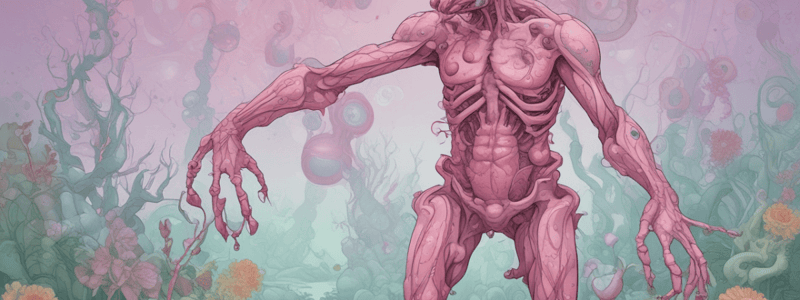Podcast
Questions and Answers
What is the likely mechanism by which rubella infection causes birth defects?
What is the likely mechanism by which rubella infection causes birth defects?
- Altered immune response in the fetus
- Mitochondrial dysfunction and apoptosis (correct)
- Direct invasion of fetal cells by the virus
- Vitamin A deficiency
Which of the following is a characteristic feature of Congenital Rubella Syndrome?
Which of the following is a characteristic feature of Congenital Rubella Syndrome?
- Growth retardation
- Cataracts (correct)
- Hepatosplenomegaly
- All of the above
What is the recommended treatment for rubella infection?
What is the recommended treatment for rubella infection?
- Supportive care
- Antiviral medication
- No specific treatment (correct)
- MMR vaccination
What is the likely outcome of rubella infection on fetal cells?
What is the likely outcome of rubella infection on fetal cells?
Which of the following is a complication of Congenital Rubella Syndrome?
Which of the following is a complication of Congenital Rubella Syndrome?
What is the primary specimen used for laboratory diagnosis and identification of Coxsackie virus during the first few days of infection?
What is the primary specimen used for laboratory diagnosis and identification of Coxsackie virus during the first few days of infection?
Which of the following complications is associated with Coxsackie virus infection in neonates?
Which of the following complications is associated with Coxsackie virus infection in neonates?
What is the primary route of transmission for rubella virus?
What is the primary route of transmission for rubella virus?
What is the primary mechanism by which the cold virus causes sore throat?
What is the primary mechanism by which the cold virus causes sore throat?
What is the role of retinoic acid in fetal development?
What is the role of retinoic acid in fetal development?
Why is serology not a reliable method for diagnosing Coxsackie virus infection?
Why is serology not a reliable method for diagnosing Coxsackie virus infection?
What is the purpose of reverse transcription PCR in the diagnosis of Coxsackie virus infection?
What is the purpose of reverse transcription PCR in the diagnosis of Coxsackie virus infection?
What is the primary complication of rubella virus infection during the first trimester of pregnancy?
What is the primary complication of rubella virus infection during the first trimester of pregnancy?
What is the laboratory diagnostic method used to detect rubella virus antibodies?
What is the laboratory diagnostic method used to detect rubella virus antibodies?
What is the characteristic rash of rubella virus infection?
What is the characteristic rash of rubella virus infection?
What is the primary site of replication for poliovirus?
What is the primary site of replication for poliovirus?
What percentage of individuals infected with poliovirus exhibit symptoms affecting the brain and spinal cord?
What percentage of individuals infected with poliovirus exhibit symptoms affecting the brain and spinal cord?
What is the composition of the poliovirus genome?
What is the composition of the poliovirus genome?
What is the most common vaccine type used to prevent poliovirus infection?
What is the most common vaccine type used to prevent poliovirus infection?
What is the primary sample used for the detection of poliovirus in the laboratory?
What is the primary sample used for the detection of poliovirus in the laboratory?
What is the primary way to reduce the risk of getting colds?
What is the primary way to reduce the risk of getting colds?
What is the characteristic structure of Rotavirus?
What is the characteristic structure of Rotavirus?
Which of the following is NOT a way to ease symptoms of colds?
Which of the following is NOT a way to ease symptoms of colds?
What is the most common cause of endemic severe diarrheal disease in infants and young children worldwide?
What is the most common cause of endemic severe diarrheal disease in infants and young children worldwide?
What is the primary mode of transmission of rhinovirus?
What is the primary mode of transmission of rhinovirus?
What is the method used to confirm rhinovirus infection?
What is the method used to confirm rhinovirus infection?
What is the shape of the rhinovirus capsid?
What is the shape of the rhinovirus capsid?
Which of the following is a complication of rhinovirus infection?
Which of the following is a complication of rhinovirus infection?
What is the receptor used by rhinovirus to enter host cells?
What is the receptor used by rhinovirus to enter host cells?
What is the typical site of rhinovirus replication in the host?
What is the typical site of rhinovirus replication in the host?
What is the primary mechanism by which rotavirus causes watery stool?
What is the primary mechanism by which rotavirus causes watery stool?
What is the characteristic feature of the viruses in the Paramyxoviridae family?
What is the characteristic feature of the viruses in the Paramyxoviridae family?
What is the primary role of the proteins in viral envelope formation?
What is the primary role of the proteins in viral envelope formation?
What is the primary method of transmission for rotavirus?
What is the primary method of transmission for rotavirus?
What is the primary complication of rotavirus infection in infants and children?
What is the primary complication of rotavirus infection in infants and children?
What is the laboratory diagnosis method used to detect rotavirus?
What is the laboratory diagnosis method used to detect rotavirus?
What is the primary treatment for rotavirus infection?
What is the primary treatment for rotavirus infection?
What is the primary control measure for rotavirus infection?
What is the primary control measure for rotavirus infection?
What is the morphology of the rotavirus?
What is the morphology of the rotavirus?
What is the characteristic feature of the viral genome in Paramyxoviridae?
What is the characteristic feature of the viral genome in Paramyxoviridae?
Rubella virus is a double-stranded RNA virus.
Rubella virus is a double-stranded RNA virus.
The only known host of the rubella virus is the fetus.
The only known host of the rubella virus is the fetus.
Vitamin A treatment is used to prevent rubella infection.
Vitamin A treatment is used to prevent rubella infection.
Congenital rubella is often seen in pregnant mothers who have received booster shots.
Congenital rubella is often seen in pregnant mothers who have received booster shots.
The rubella virus infects cells in the lower respiratory tract.
The rubella virus infects cells in the lower respiratory tract.
The incubation period of rubella is 7 days or less.
The incubation period of rubella is 7 days or less.
Viremia develops after 10 days and lasts until antibodies appear.
Viremia develops after 10 days and lasts until antibodies appear.
The rubella virus is transmitted through skin contact.
The rubella virus is transmitted through skin contact.
The rise of antibody will coincide with the disappearance of the rash.
The rise of antibody will coincide with the disappearance of the rash.
Unvaccinated children are not a high-risk population for rubella infection.
Unvaccinated children are not a high-risk population for rubella infection.
Match the following clinical manifestations of Congenital Rubella Syndrome with their descriptions:
Match the following clinical manifestations of Congenital Rubella Syndrome with their descriptions:
Match the following mechanisms of rubella infection with their effects on fetal cells:
Match the following mechanisms of rubella infection with their effects on fetal cells:
Match the following characteristics of Congenital Rubella Syndrome with their descriptions:
Match the following characteristics of Congenital Rubella Syndrome with their descriptions:
Match the following terms related to rubella infection with their meanings:
Match the following terms related to rubella infection with their meanings:
Match the following features of CRS with their descriptions:
Match the following features of CRS with their descriptions:
Match the following prevention and control measures for rubella with their descriptions:
Match the following prevention and control measures for rubella with their descriptions:
Match the following effects of rubella infection on fetal cells with their descriptions:
Match the following effects of rubella infection on fetal cells with their descriptions:
Match the following characteristics of rubella virus with their descriptions:
Match the following characteristics of rubella virus with their descriptions:
Match the following clinical features of CRS with their descriptions:
Match the following clinical features of CRS with their descriptions:
Match the following terms related to rubella infection with their meanings:
Match the following terms related to rubella infection with their meanings:





